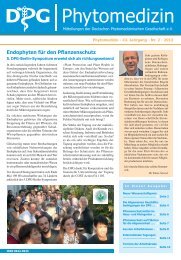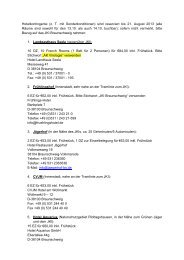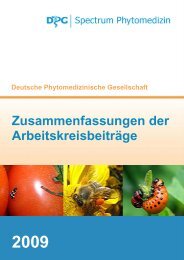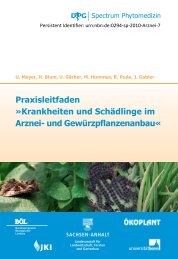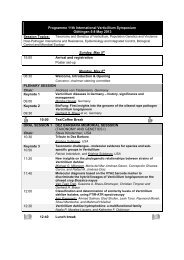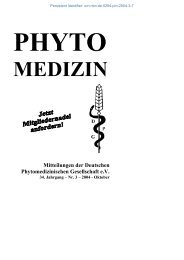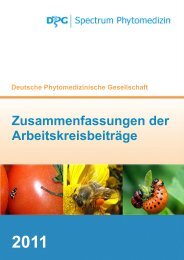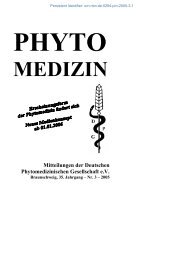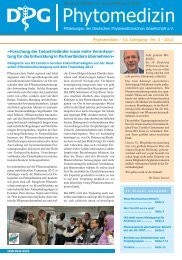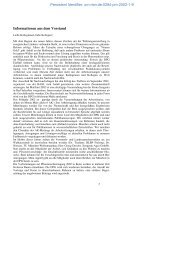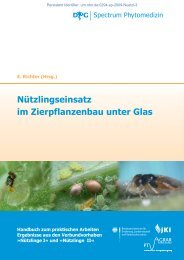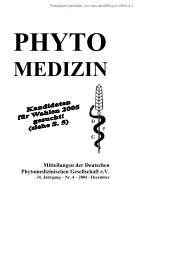fourth joint meeting of dutch and german
fourth joint meeting of dutch and german
fourth joint meeting of dutch and german
Create successful ePaper yourself
Turn your PDF publications into a flip-book with our unique Google optimized e-Paper software.
NeRNV, a new tymovirus with a genomic RNA having a histidylatable tobamovirus-like 3’end<br />
S Barends 1 , R Koenig 2 , AP Gultyaev 3 , D-E Lesemann 2 , HJ Vetten 2 , S Loss 2 <strong>and</strong> CWA Pleij 1<br />
1 Leiden Institute <strong>of</strong> Chemistry, Leiden University, 2 Biologische Bundesanstalt für L<strong>and</strong>- und<br />
Forstwirtschaft, Institut für Pflanzenvirologie, Mikrobiologie und biologische Sicherheit,<br />
Braunschweig <strong>and</strong> 3 Institute <strong>of</strong> Biology, Leiden University<br />
E-mail: barends@chem.leidenuniv.nl.<br />
The complete nucleotide sequence has been determined for the genomic RNA <strong>of</strong> the new Nemesia<br />
ring necrosis virus (NeRNV) which is widely spread in various ornamental plant species belonging<br />
to the Scrophulariaceae <strong>and</strong> Verbenaceae. Judged from its gene content, the folding properties <strong>of</strong><br />
its 5’untranslated region <strong>and</strong> from in vitro translation experiments, NeRNV RNA is a typical<br />
tymovirus RNA. Its 3’end, however, differs greatly from those <strong>of</strong> the valine-specific tymoviral RNAs<br />
which have been analysed previously. It can be folded into an upstream pseudoknot domain (UPD)<br />
<strong>and</strong> a histidine-specific tRNA-like structure (TLS), a combination which so far has been found only<br />
for tobamoviral RNAs. The identity elements found in NeRNV RNA for the recognition by yeast<br />
histidyl-tRNA synthetase are more similar to those <strong>of</strong> yeast tRNA His than the ones found in Tobacco<br />
mosaic virus (TMV) RNA. As a result NeRNV RNA can be charged with histidine even more<br />
efficiently than TMV RNA.<br />
Identification <strong>and</strong> detection <strong>of</strong> a closterovirus from carrot in Germany<br />
W Menzel, D-E Lesemann <strong>and</strong> HJ Vetten<br />
Federal Research Center for Agriculture <strong>and</strong> Forestry, Institute for Plant Virology, Microbiology <strong>and</strong><br />
Biosafety, Braunschweig<br />
E-mail:h.j.vetten@bba.de<br />
Following dsRNA isolation from a stunted <strong>and</strong> chlorotic carrot plant growing in a seed propagation<br />
plot near Bingenheim, Hessen, Germany, a complex pattern <strong>of</strong> dsRNA b<strong>and</strong>s was obtained. Since<br />
one <strong>of</strong> the dsRNAs had a notably high molecular weight, it was used as starting material for<br />
r<strong>and</strong>om RT-PCR, cloning <strong>and</strong> sequencing. Several clones were obtained which shared sequence<br />
similarity with viruses <strong>of</strong> the genus Closterovirus. A stretch <strong>of</strong> about 12,000 nucleotides comprising<br />
the complete 3’ half <strong>of</strong> the genome <strong>of</strong> the carrot closterovirus (CCV) was sequenced <strong>and</strong> analysed.<br />
Based on the hsp70h gene, which is commonly used for illustrating relationships in the family<br />
Closteroviridae, CCV is most closely related to Beet yellow stunt virus <strong>and</strong> Beet yellows virus, with<br />
which it shares hsp70h amino acid sequence similarities <strong>of</strong> 49% und 48% respectively. Moreover,<br />
CCV has a genomic organisation characteristic <strong>of</strong> the genus Closterovirus <strong>and</strong>, thus, can be confidently<br />
assigned to the genus Closterovirus <strong>of</strong> the family Closteroviridae. In attempts to develop a<br />
serological detection method for CCV, the major coat protein (CP) gene <strong>of</strong> CCV was expressed in<br />
E. coli <strong>and</strong> the resulting protein preparation was used for polyclonal antibody (PAb) production in a<br />
rabbit. These PAbs allowed visualisation <strong>of</strong> numerous closterovirus-like particles by<br />
immunosorbent electron microscopy. CCV particles had a normal length <strong>of</strong> 1600 nm <strong>and</strong> a width <strong>of</strong><br />
12 nm. In Western-blot experiments, the PAbs reacted with a protein b<strong>and</strong> <strong>of</strong> about 25 kDa which<br />
was only present in CCV-infected but not in non-infected carrot plants. PAbs also permitted<br />
sensitive detection <strong>of</strong> CCV in field carrot samples by DAS-ELISA. A reference sample <strong>of</strong> Carrot<br />
yellow leaf virus (CYLV) from the Netherl<strong>and</strong>s also gave a strong Western-blot reaction with the<br />
PAbs to CCV CP. Therefore, we regard CCV as a German isolate <strong>of</strong> CYLV, the only known<br />
closterovirus infecting Apiaceae.<br />
A new strain <strong>of</strong> Cowpea mild mottle virus infects French bean in Spain <strong>and</strong> Morocco<br />
JThJ Verhoeven 1 , JW Roenhorst 1 , CCC Jansen 1 , R Miglino 2 , AR van Schadewijk 2 , E Segundo 3 , IM<br />
Cuadrado 3 <strong>and</strong> D Janssen 3<br />
1 Plant Protection Service, Wageningen, 2 Bulb Inspection Service, Lisse <strong>and</strong> 3 Dirección General de<br />
Investigación y Formación Agraria, El Ejido, Spain<br />
E-mail: j.th.j.verhoeven@minlnv.nl<br />
In Spain recently two new virus diseases in French bean (Phaseolus vulgaris) have been reported,<br />
caused by Southern bean mosaic virus ( SBMV, Verhoeven et al., 2003) <strong>and</strong> bean yellow disorder<br />
virus BnYDV, Segundo et al., 2004), respectively. During autumn 2003, another disease turned up.<br />
Pods <strong>of</strong> infected plants showed necrotic spots at the time <strong>of</strong> harvesting, while obvious leaf<br />
16



